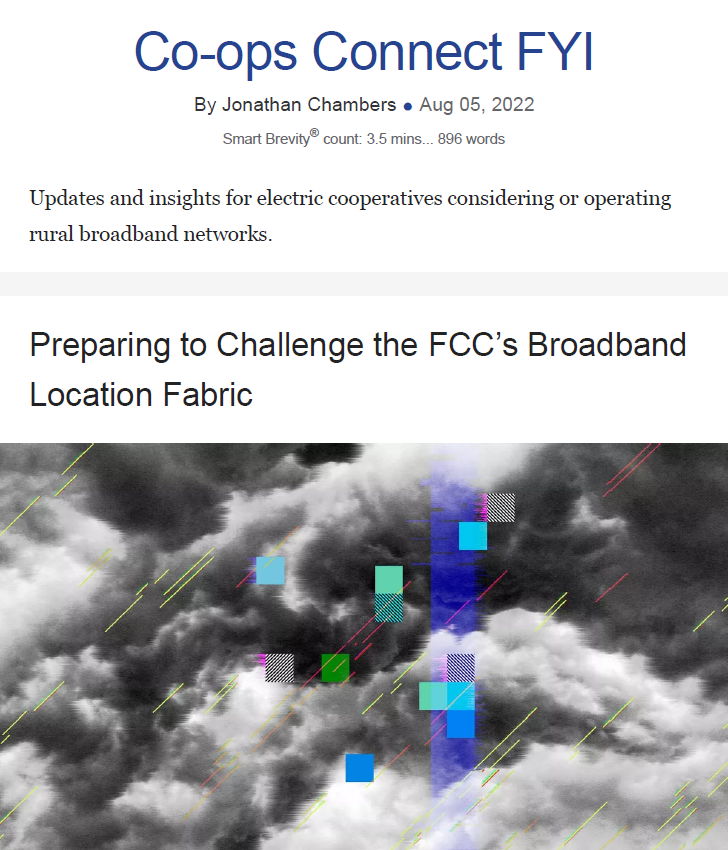Preparing to Challenge the FCC’s Broadband Location Fabric
August 5, 2022
Recap from last week:
The FCC is currently collecting two sets of broadband availability data.
- Who must file? Facilities-based providers of fixed and mobile broadband internet access who have one or more end user connections in service on June 30, 2022.
- Internet service providers must submit their availability data for the initial Broadband Data Collection filing no later than September 1, 2022.
- Both FCC Form 477 and new Broadband Data Collection filings are required.
- The bottom line from NTIA:
“Companies who do not timely submit their Broadband Data Collection and FCC Form 477 data in the correct format to the FCC will be ineligible for the Broadband Equity, Access, and Deployment (BEAD) Program subgrants in the states in which they operate.”
What is the Location Fabric?
The Broadband Serviceable Location Fabric (Fabric) is a dataset that includes all locations in the United States and U.S. Territorieswhere fixed broadband internet access service has been or could be installed.
- This dataset is being prepared by an FCC contractor (CostQuest) with oversight by the FCC.
What’s next:
If you have not already obtained access to the Fabric, it is critical that you initiate the process to obtain that access.
How to access the Fabric:
1. You must enter into a limited end-user license agreement with CostQuest, which is the FCC’s third-party provider of the Fabric.
2. Email CostQuest at [email protected] to request access to your BDC Fabric.
- Include the name and email of the provider’s contact person, the provider’s name, and the provider’s FCC Registration Number (FRN).
- If you have previously filed FCC Form 477, you will be able to access the Fabric faster if the contact person provided in the email is someone who can sign the Fabric license agreement on behalf of the company.
- If you have not previously filed FCC Form 477, you must indicate you have not previously filed Form 477.
3. CostQuest will send the provider’s contact person a New Entity
Information Sheet to be completed and returned to CostQuest.
4. CostQuest will forward the completed New Entity Information Sheet to the FCC for review and approval.
5. Once FCC approval is received by CostQuest, the provider’s contact will receive additional instructions from CostQuest regarding account setup and the licensing process.
Why is the Location Fabric Important?
In short, most rural broadband funding (including BEAD and RDOF) will be based on the Fabric.
Go deeper:
1. The Fabric is the basis for the FCC’s count of unserved locations.
- Unserved locations are locations that lack 25/3 Mbps.
- The FCC’s count will be used to allocate $42.5 billion in rural broadband funding to states.
- For a state, every unserved location that is counted will likely be worth $3,000-4,000 in the BEAD allocation.
2. The statutory language underlying the BEAD program requires that “unserved service projects” be prioritized over all other broadband needs.
Unserved are those projects where at least 80% of locations are unserved.
Underserved locations are those that lack access to 100/20 Mbps.
Underserved service projects are likewise prioritized over other projects, such as community anchor institutions.
3. The FCC will likely use the Fabric to identify RDOF locations.
- The RDOF count of locations in each biddable census block was largely based on the 2010 census and did not include address data for the locations.
- The Fabric is the most likely source of addresses that an RDOF recipient must be able to serve to satisfy its build-out obligation.
The Challenge Process
After the FCC makes the new broadband maps public, there will be an opportunity to improve the Fabric through a challenge process.
Conexon’s leadership believes that electric co-op GIS data is the gold standard for broadband data. An electric meter is a serviceable location for electricity and for broadband.
- The Conexon approach to building broadband is to design fiber to the location of every electric meter.
- Essentially every location with an electric meter is a potential fiber customer – a serviceable location.
- Why it matters: Comparing these locations to Fabric locations, and challenging the Fabric where necessary, will improve the FCC’s maps.
The bottom line:
Our preliminary analysis of the Fabric is that over 10% of the locations where we would design and build a fiber network are missing from the Fabric.
The Big Picture
I anticipate challenges to (a) the Fabric and (b) ISP-reported speeds at individual locations will number in the millions, and potentially tens of millions, of locations.
The FCC contemplates a process to review and adjudicate each challenge of each location.
- The location Fabric itself may be missing millions of broadband serviceable locations.
- Challenges reported by DSL, fixed wireless, and cable are more complicated than the location of physical structures.
- Every state with a broadband map, every underserved community, and every ISP could be engaged in the challenge process. The FCC does not have the resources to handle challenges on such a scale.
The bottom line:
There is no possibility that the FCC’s contemplated challenge process will work.
Something’s gotta give. Unfortunately, the thing that will most likely give is the accuracy of maps.
There is a better way, which I will articulate in weeks to come.
Next week, I’ll display a set of examples to show the difference between electric GIS data and the Fabric dataset.
